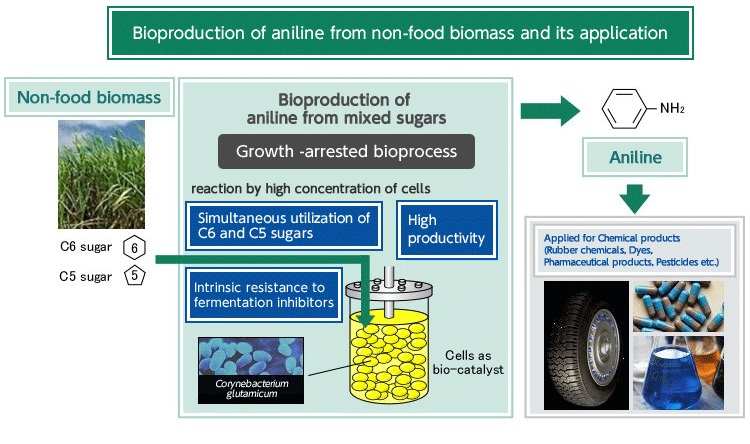- Biotechnology group>
- Production of green chemicals>
- Aromatic compounds
Production of green chemicals
Aromatic compounds
Phenol
Reduction of dependence on fossil resource, and replacement from energy-consuming chemical industry process at high temperature and high pressure to energy saving bioprocess at ordinary temperatures and pressures are trends for innovative advanced technology. Therefore, the targets for research and development in the field of green chemicals are continuing to grow.
Phenolic resin having 100-years of history, because of its superior properties such as heat-resistance, mechanical characters, excellent electrical insulation, and flame resistance, it has been used for automobile parts, circuit boards, and adhesive bonds for wood processing etc...
Phenol, one of the aromatic compounds, is used as a monomer for phenolic resin and is produced from petroleum.
Because of its high cytotoxicity, high production of phenol by bioprocess has been believed to be extremely difficult.

<Application of phenol>

<Current chemical process for industrial production of phenol (Cumene process)>
Our research group succeeded to construct and improve recombinant strains of C. glutamicum ex. Simultaneous utilization of C5 and C6 sugars from non-food biomass through metabolic engineering is one of the major obstacles to be overcome for industrialization, but we already overcome this point.
Recently, we succeeded in constructing two-step bioprocess(sugars → 4-hydroxybenzoate(4-HBA), 4-HBA→ phenol) for high production of green phenol to reduce cytotoxicity of phenol. Based on our original bioprocess and methods, we collaborate energetically with Sumitomo Bakelite Co. Ltd. to facilitate early realization of industrialization of green phenol production.

<Bioprocess for green phenol production>
Aniline
Aniline is produced by the reduction of nitrobenzene, which is produced from the nitration of benzene in a mixture of sulfuric and nitric acid, and following distillation. Then, aniline is obtained by catalytic reduction method, which consists of heating for reduction under hydrogen and metal catalysis, and reduced-pressure distillation. This oil-dependent process needs high temperature and generates large quantities of waste because of neutralization of the mixed acids.
In contrast, bioproduction of aniline by growth-arrested bioprocess can be performed at ordinary temperatures and pressures, and no production of toxic wastes from non-food biomass. Therefore, this is the environmentally friendly way for bioproduction of aniline. C. glutamicum is more resistant to aniline compared to E. coli. Thus, C. glutamicum is a superior host for production of aniline.
The unique growth-arrested bioprocess using enforced aniline-producing C. glutamicum can produce aniline from mixed sugars (C5 and C6 mixture) prepared from non-food biomass.

<Chemical procedures for aniline production (high temp. and large amount of wastes) >
Many metabolic steps are needed for production of aromatic compounds. Most aromatic compounds are hydrophobic and highly cytotoxic, therefore it is hard for bioproduction. However, C. glutamicum is a superior industrial microorganisms because it is an actual workhorse for industrial production of amino acids, biological safety, it is absolutely resistant to many kinds of aromatic compounds, and hard to lyse. Therefore, we believe C. glutamicum is a superior host for bioproduction of many kinds of aromatic compounds. By using RITE original growth-arrested bioprocess with the metabolically engineered strain, large amounts of the desired compounds can be produced in high yield.
Mixed sugars from non-food biomass contains both C5- and C6-sugars, many microorganisms assimilate C6-sugars preferentially than C5-sugars. This means that many microorganisms can assimilate C6-sugars initially, after consumtion of the C6 sugars, they start assimilation of C5 sugars. Many microorganisms usually produce the desired compounds during growth, the ordered sugar assimilation profile is not preferred for production of the desired compounds because it wastes large amount of time and the productivity will be declined.
However, the metabolically engineered C. glutamicum can assimilate mixed sugars simultaneously under growth independent condition, the cells can be used as stable- and continuous enzyme reactor, it can produce large amount of the desired compounds at high yield.

<Bioproduction of aniline from non-food biomass and its application>
